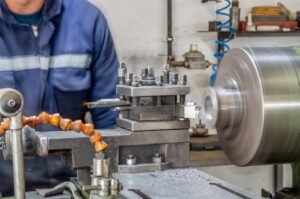For sectors requiring minuscule components with absolute precision, Swiss-type lathes are the preferred solution. Unlike conventional turning machines, these lathes are purpose-built for micron-level tolerances, intricate geometries, and slender workpieces. From medical implants to aerospace connectors, their ability to combine multiple machining steps into one uninterrupted process makes them indispensable.
Think of a Swiss lathe as the watchmaker’s tool scaled for modern industries: a machine that can create life-saving implants, aircraft fittings, or smartphone connectors—all with the same commitment to precision.
Core Features of Swiss Lathes
The engineering behind Swiss-style lathes is key to their exceptional precision.
- Sliding headstock & guide bushing: By supporting the workpiece close to the cutting tool, these machines minimize vibration and deflection. This makes them perfect for long, slender parts such as guidewires or shafts.
- Multi-tool, multi-axis operations: With as many as 12 axes and live tooling, Swiss lathes perform turning, milling, drilling, and tapping in one setup. This reduces cycle time, ensures repeatability, and eliminates costly secondary machining.
- Material versatility: They cut stainless steel, titanium, aluminum, and exotic alloys that are otherwise difficult to process.
Case in point: A medical device manufacturer producing titanium bone screws completes threading and slotting in one pass. No re-clamping means no misalignment—a crucial advantage for safety-critical implants.
Medical & Dental Applications
In healthcare, precision isn’t optional—it’s the difference between success and failure. Swiss lathes play a central role here.
- Bone screws and implants: Orthopedic screws measuring less than 2 mm in diameter must endure heavy stress. Swiss screw machining guarantees uniformity in high-volume production runs.
- Guidewires and stents: With ultra-fine diameters and smooth finishes, these devices can safely move through arteries without damaging tissue.
- Dental instruments: Tools such as implant abutments and surgical drills require both durability and immaculate surface finishes.
Case study: A U.S.-based medical device company reduced implant rejection rates by 25% after switching to Swiss machining for titanium parts. Better surface quality and dimensional stability directly translated into safer outcomes (source: SME Manufacturing Engineering).
Aerospace & Defense Applications
In aerospace and defense, reliability under extreme conditions is non-negotiable. A single defective micro-component can compromise an entire system.
- Components like turbine blades and enclosures: Swiss lathes fabricate miniaturized parts, maintaining tolerances within ±5 microns.
- Hydraulic fittings and connectors: These must withstand high pressure and rapid temperature fluctuations.
- Defense components: Precision ammunition parts and navigation system components are routinely made using Swiss turning.
Aerospace example: An aerospace supplier adopted Swiss lathes to machine micro-fuel injector nozzles. The result: 40% shorter cycle times and defect-free sub-millimeter holes that conventional CNC lathes struggled to produce.
Automotive & Electronics Applications
Swiss lathes are equally advantageous in applications demanding rapid production and easy scalability.
- Automotive: Components like fuel injector nozzles, ABS sensor housings, and small shafts must meet strict tolerances. Even a fraction of an error can cause system inefficiency or failure.
- Electronics: Miniature connectors, terminals, and pins demand extreme repeatability—often across millions of units.
- MEMS devices: These micro-electromechanical systems, essential to sensors and microchips, often rely on Swiss turning for their tiny precision parts.
Practical example: A global electronics manufacturer used Swiss lathes to mass-produce smartphone connectors. They maintained tolerances within ±2 microns while reducing per-unit cost—an unbeatable advantage in a high-volume market.
Emerging & Niche Industries
Beyond mainstream sectors, Swiss lathes support niche applications where precision is equally critical.
- Musical instruments: Woodwind and brass fittings require uniform machining to maintain consistent sound quality.
- Oil & gas: Valves and pump components made from superalloys like Inconel can be reliably machined.
- Watchmaking: Originally designed for Swiss watches, these lathes remain the gold standard for ultra-small, high-precision components.
Here, Swiss machining isn’t just a production method—it’s often a defining part of the product’s value and heritage.
Case Studies & Examples
Real-world examples illustrate the measurable impact of Swiss turning.
- Medical implants: Cycle time for titanium bone screws dropped from 7 minutes to 3 minutes when switching from standard CNC to Swiss machining.
- Aerospace turbines: Consistency was maintained at ±1 micron over thousands of turbine components, improving both quality and throughput.
- Automotive sensors: Just-in-time production of injector parts became feasible, cutting inventory costs by 15% without compromising reliability.
These cases show that Swiss machining doesn’t just promise precision—it delivers cost savings, efficiency, and repeatability at scale.
Summary Table of Part Examples by Industry
| Industry | Example Components | Key Requirements |
| Medical | Bone screws, stents, guidewires | Biocompatibility, micro-precision |
| Aerospace | Turbine blades, hydraulic fittings | Heat resistance, tolerance repeatability |
| Automotive | Fuel injector nozzles, sensor housings | High-volume accuracy, durability |
| Electronics | Connectors, pins, MEMS parts | Micro-size, repeatability |
| Niche | Watch parts, musical fittings, valves | Material diversity, heritage precision |




